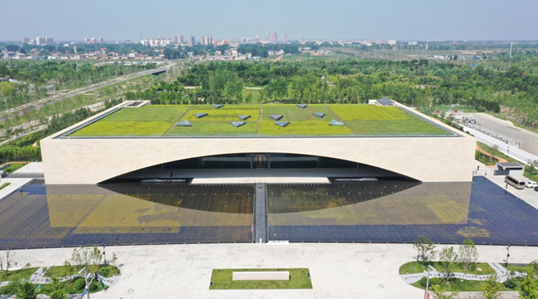By Wan Xiubin, Zhang Zhifeng, Zhang Tengyang, People’s Daily
On April 1, 2017, the Chinese government decided to establish Xiong’an New Area in north China’s Hebei province. Over the past seven years, Xiong’an New Area has transformed from a blueprint to reality, seeing a total investment of over 670 billion yuan ($92.62 billion) in key projects, with more than 4,000 buildings constructed. A high-level modern city is taking shape.
Green development is the defining feature of Xiong’an New Area. In the start-up area stands the headquarters building of China Huaneng Group, one of the initial centrally-administered state-owned enterprises to be relocated from Beijing. Environmental protection is a key consideration in every aspect of the building’s construction and operation.
“We built a comprehensive energy system for the building, utilizing technologies such as ground source heat pumps to achieve clean and efficient heating and cooling. Photovoltaic modules are installed on the roof and facade of the building to provide green electricity,” said Liu Shaohua, head of the comprehensive department of China Huaneng Group’s Xiong’an branch.
This spring, high-quality green spaces and parks like the Yuerong Park have opened to the public for free, becoming a popular destination for citizens.
Prioritizing green development, Xiong’an New Area had planted a huge number of trees before the urban construction commenced. So far, a total of 478,000 mu (31,867 hectares) of forests have been planted, raising the forest coverage rate to 34.9 percent from 11 percent before the new area was constructed.
The Xiong’an sports center is the largest public sports facility in Xiong’an New Area, with the main stadium being the largest single building in terms of construction area.
“Unlike typical venues, the main stadium boasts a prefabricated steel construction for its upper portion. To ensure higher quality, the height of excess weld seam on the steel structure is controlled within 2 millimeters, twice as stringent as normal standards,” said Yao Wenbo, project manager of the Xiong’an sports center with Beijing Urban Construction Group Co., Ltd.
As a matter of fact, high standards and high quality permeate every aspect of the construction of public infrastructure, transportation, industrial parks, and residential areas in Xiong’an New Area.
Xiong’an advances high-quality development with innovative approaches. It follows a principle of building underground infrastructure prior to the aboveground construction, and plans and builds digital city and physical city in parallel. As a result, it has witnessed simultaneous development of underground infrastructure, aboveground buildings and cloud-based systems.
So far, Xiong’an has implemented 383 key projects with a total construction area of 43.7 million square meters, and has built approximately 97.3 kilometers of utility tunnels.
In the past seven years, around 120,000 residents have moved to newly built districts such as Rongdong, Rongxi, and Xiongdong.
As a new city with new communities, how is Xiong’an New Area modernizing urban governance?
Xiong’an New Area has established a “city brain” management system supported by the Xiong’an Urban Computing Center, an Internet of Things platform, a video surveillance network, an information modeling platform, and a block data platform. This system has made urban services and management more intelligent, human-centric, and targeted.
Both intelligent urban management and caring urban services are offered in Xiong’an. Wang Kun, deputy director of the Rongdong urban operations and management center, said after obtaining consent from senior residents living alone, the center monitors their water usage every morning and evening. Whenever there is no water usage detected, an alert will be triggered and sent to community workers to promptly check on the senior residents. Currently, over 200 senior residents living alone in Rongdong benefit from this smart service.
In newly built districts of Xiong’an, a 15-minute “living circle” has been thoughtfully designed, providing residents with easy access to community canteens, senior care facilities, health service centers, schools, supermarkets and other amenities, all aimed at improving their overall well-being.
As a major recipient of functions transferred from Beijing that are not essential to its role as China’s capital, Xiong’an New Area is gaining more carrying capacity and appeal.
China Telecom has transferred its entire digital city business to Xiong’an, where it established the China Telecom Digital City Technology Co., Ltd..
“Xiong’an New Area seeks to achieve high-quality development through effective measures in relieving Beijing of non-essential functions related to its status as the nation’s capital. Its development as an intelligent city has opened up ample opportunities for the application of new technologies,” said Hu Junjun, head of the R&D department of China Telecom Digital City Technology Co., Ltd.
The company has developed an intelligent transportation system and built 153 kilometers of regional-level digital roads in Rongdong to explore applications including autonomous driving, according to Hu. The Xiong’an New Area Zhongguancun Science Park has been operating for seven months now and during this time, it has launched over 30 events and connected with more than 2,000 enterprises.





